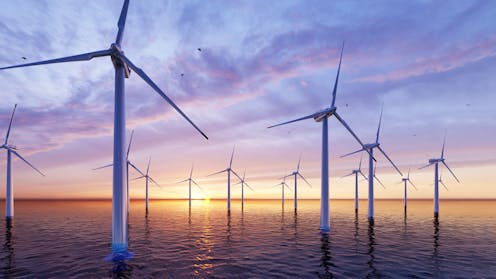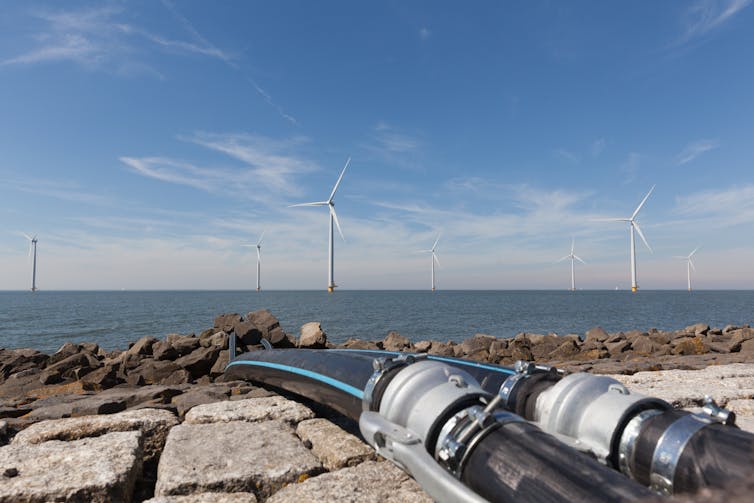
The UK government’s strategy for tackling climate change received a major blow in May when Danish developer Ørsted announced that adverse economic developments had halted its 2.4 gigawatt (GW) Hornsea 4 wind farm in the North Sea.
The government aims to generate at least 43GW of offshore wind power (current capacity is 14.7GW) and 95% of all energy from renewable sources by 2030.
These targets are now in jeopardy. The cancellation of Hornsea 4 follows a similar decision by Swedish developer Vattenfall, which stopped work on its 1.4GW Norfolk Boreas wind farm in 2023.
What is forcing renewable energy developers to pull out when they are due to make their final investment decision?
Get your news from actual experts, straight to your inbox. Sign up to our daily newsletter to receive all The Conversation UK’s latest coverage of news and research, from politics and business to the arts and sciences.
The offshore wind industry is exposed to fluctuations in the prices of raw materials necessary to meet rising global demand for renewable energy. This vital part of the energy transition, alongside the phaseout of fossil fuels, has been impeded by inflation caused by the pandemic and the war in Ukraine.
Building a wind turbine requires significant amounts of steel, copper and aluminium, all of which doubled or tripled in price between 2020 and 2023. Turbine manufacturers have raised prices in an effort to recover recent losses. This affects the profitability forecasts of wind energy developers like Ørsted and the viability of each of their projects.
Impending national and international net zero targets also mean that developers globally are having to make earlier investments in transmission infrastructure. An exponential increase in demand for scarce high-voltage cabling has already led to high-profile cancellations of offshore wind farms in the US.

Rising demand for rare earth metals used to make magnets in turbine generators has also been snared by geopolitical issues. The mining, processing and refining of these metals is dominated by China, which manufactures over 90% of these magnets.
A shortage of boats
Developers need boats to build offshore wind farms. Here lies another strain on the timescales of developers.
Ørsted ceased work on its 2.2GW Ocean Wind development zone off the coast of New Jersey in 2023, citing a vessel delay in its decision to cancel the project.
According to the advocacy group WindEurope, demand for vessels capable of installing foundations and turbines and laying cables will outstrip availability within the next five years. The gap between the two is forecast to skyrocket between 2028 and 2030. This will make it harder to commission the wind farms that the UK government is relying on to reach its 43GW target by the end of the decade.
Delays caused by these issues can result in a problem known as “contract erosion”. In their contracts, developers have a commissioning window within which turbines have to start generating. If they are not operational within this time, they lose their subsidies on a day-by-day basis.
Rising costs mean that even one of the world’s biggest wind farms, Dogger Bank in the North Sea, will not be profitable for its developer, Equinor. As a prospect for generating financial returns, renewable energy still cannot compete with oil and gas.
This is the key argument of economic geographer Brett Christophers in his recent book The Price is Wrong. Christophers argues that, if national governments continue to rely so heavily on private sector investment to build renewable energy, decarbonisation is unlikely to proceed as fast as it needs to. It is simply not profitable enough.
Misguided planning reform
How might the UK defy difficult global conditions and meet its 43GW target by 2030? So far, the government’s main proposal has been to relax timelines for the planning process of wind farms.
Earlier in 2025 it opened a consultation on reforms to the contracts for difference process, which is how developers bid for long-term energy generation contracts, prior to an auction round in summer 2025.
The main proposed change was to allow developers of fixed-bottom offshore wind projects to bid in the auction before receiving a development consent order, or a DCO. A DCO defines the approved scope of a development, taking into account environmental surveys, land rights and developer proposals.
It can take more than two years for a DCO to be awarded. The government hopes that fast-tracking fixed-bottom developments will result in more contracts being awarded in the latest auction, but will this work?
The government is aware of the risks. Planning permission could be refused after a contract has been awarded, and projects without consent face even greater uncertainty over costs than developments that already have a DCO.
The government might be able to get more projects into the pipeline, but the supply chain is already stretched to its limits. Through the state-owned investment body GB Energy, the government has pledged £300 million to bolster the domestic supply chain for components required for offshore wind, like platforms and cabling.
However, this investment largely focuses on new technologies for floating offshore wind, leaving fixed-bottom projects like Hornsea 4 at the mercy of vessel delays and raw material price rises. If something does not change to mitigate costs and increase returns for developers, the government’s 2030 target is in doubt.
Don’t have time to read about climate change as much as you’d like?
Get a weekly roundup in your inbox instead. Every Wednesday, The Conversation’s environment editor writes Imagine, a short email that goes a little deeper into just one climate issue. Join the 45,000+ readers who’ve subscribed so far.
Thomas York receives funding from the University of Leicester's Future 50 doctoral training pathway.
This article was originally published on The Conversation. Read the original article.







